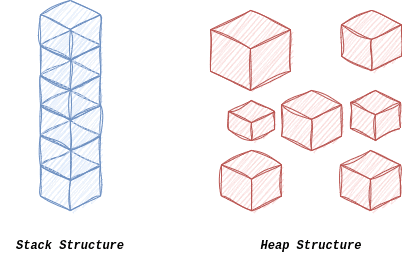Learn through the super-clean Baeldung Pro experience:
>> Membership and Baeldung Pro.
No ads, dark-mode and 6 months free of IntelliJ Idea Ultimate to start with.
Last updated: May 11, 2024
Memory is the storage area a computer employs to store data and instructions. It consists of several cells, each of which has a specific address indicating its location. During the execution of a program, data and instructions are retrieved from memory using these addresses.
Memory is fundamental to the proper functioning of computer systems and is categorized into stack memory and heap memory.
In this tutorial, we’ll examine stack and heap memory, how they differ, and where they fit into a computer’s memory space.
In programming, whenever a function is called, the program generates a new stack memory block for the function to utilize. This type of memory is located in the stack section of a program’s memory space, which is a reserved restricted memory area. This section is usually located at the top of the memory space and grows downward as more data is added.
Stack memory employs an automatic allocation and deallocation of memory that stores temporary data created by functions or procedures. Stack memory uses a “Last In, First Out” (LIFO) data structure, meaning that the most recently added item is the first to be removed. When the function or procedure is finished executing, the stack memory block is released automatically, and the program returns to the previous point of execution.
Stack memory is useful in managing memory usage as it avoids memory leaks due to its architecture. Moreover, the stack may overflow and crash in the case of many nested function calls.
Compared to stack memory, heap memory operates dynamically, which basically means that the program can allocate and deallocate memory areas of different sizes when necessary. This allocation/deallocation of memory depends on the requirements that arise during runtime.
A program’s memory space consists of a heap section, which is reserved only for a program’s heap memory. The size of the heap partition is not fixed and can be dynamically adjusted at runtime.
In addition, heap memory is not associated with a specific function or process. The data in heap memory is not arranged in any specific pattern and can be reached in any order. Throughout a program’s runtime, only useful areas of memory are retained in heap memory.
Consequently, heap memory is suitable for dealing with large, complex data structures such as tables, linked lists, and trees and facilitates memory sharing between different program parts.
Although, occasionally, heap memory may be more challenging and lead to memory leaks or other memory-related errors.

Stack memory and heap memory differ in several ways. Their main differences are highlighted in the table below:
| Stack Memory | Heap Memory |
|---|---|
| Stores temporary data by functions and procedures | Stores data not tied to a specific function or procedure |
| LIFO data structure | No specific structure |
| Automatic allocation and deallocation by the program | Dynamic allocation and deallocation during runtime |
| Limited, fixed size | Dynamically adjusted size |
| Easy to manage | More challenging to manage |
| Faster access | Slower access |
| Used for small amounts of data | Used for large, complex data structures |
In this article, we discussed stack and heap memory in OS.
On the other hand, heap memory is a type of dynamic memory allocation used for storing objects and data structures that require a longer lifespan than stack memory.
Overall, it’s critical to comprehend the distinctions between heap and stack memory in order to optimize memory usage and the application’s performance.